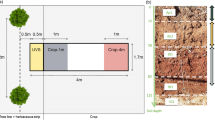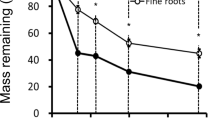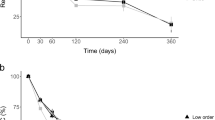Abstract
Fallowing is a common practice for the management of soil fertility in low-input cropping systems of the West-African savanna, but has been threatened by the growing need for land in the sub-region for the past few decades. Proposals for alternatives to traditional fallowing must rely on a proper understanding of the soil biochemical dynamics occurring after fallow conversion to cropping. Two mesh-bag experiments were thus conducted in two sites (dry and sub-humid tropical climates) in Senegal to assess the role of site-related factors (climate, macrofaunal activity) and root-related factors (tree species, root diameter) on the decomposition of tree roots after clearing of fallow vegetation as measured from mass loss. Root decomposition was fastest – and even faster than predicted from a global model – in the wettest site (first order disappearance rate: 1.00 y−1 and 1.46–1.49 y−1 under dry and sub-humid conditions, respectively). Macrofauna accounted for half of root mass loss in the sub-humid site, with biomass removal occurring even during the dry season. Fastest disappearance for roots with ∅<5 mm occurred for Dichrostachys cinerea, and Combretum glutinosum. The influence of root chemical composition on decomposition patterns among tree species and root diameter classes was not clear, with effects of cell wall composition and nutrient content changing throughout the incubation period. Fast disappearance of dead roots suggests that cropping practices that allow conservation of live stumps, such as no-tillage and direct sowing, be promoted wherever possible to ensure soil conservation. It also suggests the possible management of tree species composition and, to a much lesser extent, of macrofauna during the fallow period to control root decomposition patterns and related nutrient transfers to crop biomass after fallow conversion.
Similar content being viewed by others
References
Bloomfield J, Vogt K A and Vogt D J 1993 Decay rate and substrate quality of fine roots and foliage of two tropical tree species in the Luquillo Experimental Forest, Puerto Rico. Plant Soil 150, 233–245.
Bohringer A, Leihner D E and Bocker R 1996 Shoot biomass of natural stump regrowth in cropping systems in the subhumid forest savanna mosaic zone of West Africa. Tropenlandwirt 97, 225–239.
Chen H, Harmon M E, Griffiths R P and Hicks W 2000 Effects of temperature and moisture on carbon respired from decomposing woody roots. Forest Ecol. Manage. 138, 51–64.
Diack M, Sene M, Badiane A N, Diatta M and Dick R P 2000 De-composition of a native shrub, Piliostigma reticulatum, litter in soils of semiarid senegal. Arid Soil Res. Rehabil. 14, 205–218.
Ewel J J 1999 Natural systems as models for the design of sustain-able systems of land use. Agroforest. Syst. 45, 1–21.
FAO 1998 World reference base for soil resources. World Soil Re-sources Reports, Vol. 84. Food and Agricultural Organisation, Rome. 98 pp.
Floret C, Pontanier R and Serpantié G 1993 La Jachère en Afrique Tropicale. Man and Biosphere, Vol. 16. UNESCO, Paris. 86 pp.
Floret C (Ed.) 1998 Raccourcissement du temps de jachère, biodiversité et développement durable en Afrique Centrale (Cameroun) et en Afrique de l'Ouest (Mali, Sénégal): Final Report. Comm. des Communautés Européennes. Contrat TS3-CT93–0220 (DG 12 HSMU), and IRD Paris, 245 pp.
Hatcher L and Stepanski E J 1994 A step-by-step approach to using the SAS System for univariate and multivariate statistics. SAS Institute Inc., Cary, NC. 552 pp.
Heal O W, Anderson J M and Swift M J 1997 Plant litter quality and decomposition: an historical overview. In Driven by Nature: Plant Litter Quality and Decomposition. Eds. G Cadisch and K E Giller. pp. 3–30. CAB International, Wallingford.
Hulugalle N R 1994 Long-term effects of land clearing methods, tillage systems and cropping systems on surface soil properties of a tropical alfisol in S.W. Nigeria. Soil Use Manage. 10, 25–30.
Jenny H, Gessel S P and Bingham F T 1949 Comparative study of decomposition rates of organic matter in temperate and tropical regions. Soil Sci. 68, 419–432.
Jones M J and Wild A 1975 Soils of the West African Savanna. Technical Communications, Vol. 55. Commonwealth Agricul-tural Bureaux, Farnham Royal. 246 pp.
Kowal J M and Kassam A H 1978 Agricultural ecology of Savanna: A study of West Africa. Clarendon Press, Oxford, UK. 403 pp.
Lavelle P, Villenave C, Rouland C and Derouard L 2000 Dynamique des peuplements de macro-invertébrés du sol aux diverses étapes de la Jachère en Afrique tropicale. In La Jachère en Afrique Trop-icale – Vol I. Actes du Séminaire International Dakar, Senegal, 13–16/04/1999, Eds. C Floret and R Pontanier. pp. 236–241. John Libbey, Paris.
Manlay R J, Kaïré M, Masse D, Chotte J-L, Ciornei G and Floret C 2002a Carbon, nitrogen and phosphorus allocation in agro-ecosystems of a West African savanna I. The plant component under semi-permanent cultivation. Agr. Ecosyst. Environ. 88, 215–232.
Manlay R J, Masse D, Chotte J-L, Feller C, Kaïré M, Fardoux J and Pontanier R 2002b Carbon, nitrogen and phosphorus allocation in agro-ecosystems of a West African savanna II. The soil com-ponent under semi-permanent cultivation. Agr. Ecosyst. Environ. 88, 233–248.
Menaut J-C, Barbault R, Lavelle P and Lepage M 1985 African savannas: biological systems of humification and mineraliza-tion. In Ecology and Management of the World's Savannas. Eds. JC Tothill and JJ Mott. pp. 14–33. Australian Acad. Science, Canberra.
Nicholson S E, Some B and Kone B 2000 An analysis of recent rainfall conditions in West Africa, including the rainy seasons of the 1997 El Niño and the 1998 La Nina years. J. Climate 13, 2628–2640.
Nouvellet Y 2001 Mesure des processus d'érosion diffuse et concentrée dans la région de Thysse-Kaymor, Siné Saloum (Sénégal). PhD thesis, Université Paris 7, Paris.
Palm C A, Swift M J and Woomer P L 1996 Soil biological dy-namics in slash-and-burn agriculture. Agr. Ecosyst. Environ. 58, 61–74.
Pieri C 1992 Fertility of Soils: A Future for Farming in the West African Savannah. Springer Series in Physical Environment. Springer Verlag, Berlin. 348 p.
Sanchez P A, Palm C A, Szott L T, Cuevas E and Lal R 1989 Organic input management in tropical agroecosystems. In Dynamics of Soil Organic Matter in Tropical Ecosystems. Eds. D C Coleman, J M Oades and G Uehara. pp. 125–152. Niftal Project, Univ. of Hawaii.
Scheu S and Schauermann J 1994 Decomposition of roots and twigs: effects of wood type (beech and ash), diameter, site of exposure and macrofauna exclusion. Plant Soil 163, 13–24.
Serpantié G and Ouattara B 2000 Fertilité et Jachère en Afrique de l'Ouest. In La Jachère en Afrique Tropicale-Vol II. De la Jachère Naturelle à la Jachère Améliorée: Le Point des Connaissances Dakar, Senegal, 13–16/04/1999. Eds. C Floret and R Pontanier. pp. 21–83. John Libbey, Paris.
Silver W L and Miya R K 2001 Global patterns in root decomposi-tion: comparisons of climate and litter quality effects. Oecologia 129, 407–419.
Smith M J 1998 An investigation into the role played by termites in the breakdown of wood under laboratory conditions, and the in-fluence of wood species on decomposition rates. BSc, University of Greenwich.
Szott L T, Palm C A and Buresh R J 1999 Ecosystem fertility and fallow function in the humid and subhumid tropics. Agroforest. Syst. 47, 163–196.
Tian G 1992 Biological effects of plant residues with contrasting chemical compositions on plant and soil under humid trop-ical conditions. PhD Thesis, Landbouwuniversiteit, Wageningen, The Netherlands.
Van Soest P J and Robertson J B 1985 Analysis of forages and fibrous foods. A laboratory manual for animal science. Cornell University Press, Ithaca.
Wardle D A and Lavelle P 1997 Linkages between soil biota, plant litter quality and decomposition. In Driven by Nature: Plant Lit-ter Quality and Decomposition. Eds. G Cadisch and KE Giller. pp. 107–124. CAB International, Wallingford.
Whitford W G, Stinnett K and Anderson J 1988 Decomposition of roots in a Chihuahuan Desert ecosystem. Oecologia 75, 8–11.
Wood T G 1988 Termites and the soil environment. Biol. Fert. Soils 6, 228–236.
Author information
Authors and Affiliations
Rights and permissions
About this article
Cite this article
Manlay, R.J., Masse, D., Chevallier, T. et al. Post-fallow decomposition of woody roots in the West African savanna. Plant and Soil 260, 123–136 (2004). https://doi.org/10.1023/B:PLSO.0000030176.41624.d7
Issue Date:
DOI: https://doi.org/10.1023/B:PLSO.0000030176.41624.d7




